The Alaska Highway, affectionately known as the Alcan, epitomizes the ultimate road trip adventure. Stretching over 1,390 miles, it forges a path from Dawson Creek in British Columbia, Canada, to Delta Junction in Alaska, USA.
As enthusiasts of the open road, we set out from Los Angeles, embarking on a three-week exploration of Alaska before retracing our steps back home.
Our journey along the Alaska Highway was a fulfilling road-tripping adventure, blending meticulous planning with spontaneous discoveries.
It provided us with invaluable experiences and insights that we are eager to share, hoping to inspire and guide others embarking on a similar expedition.
From pre-trip preparations to unexpected roadside attractions, this post aims to serve as a comprehensive guide for anyone considering this legendary route.
Moreover, recognizing the vast scope of such an undertaking, we've also prepared an extensive guide on driving to Alaska. This resource goes deeper than mere sightseeing, offering practical advice and tips to ensure a smooth and memorable journey.

Navigating the Alaska Highway: The Essential Companion
Starting our Alaska Highway adventure, 'The Milepost' became a key guide for us. This detailed guidebook offered a comprehensive look at the route, adding a lot of valuable details to our trip.
Despite the prevalence of digital resources, flipping through 'The Milepost's pages by hand made our planning and travel more engaging, turning our copy into a well-traveled keepsake by the trip's end.
'The Milepost' was both essential and helpful, especially where digital connections were missing. It provided reassurance, proving particularly valuable in finding places to stay as evening approached.
While it didn't take the place of online booking sites, it gave us key information about nearby accommodations, offering peace of mind when we were far from the next place to rest.
In our journey, 'The Milepost' was not merely a guide for each mile; it became our indispensable ally in the most remote stretches. It also helped us anticipate the distance to the next rest stops or accommodations.
Though lacking the convenience of instant online bookings and user reviews, the guide's reliable information on potential resting spots was invaluable.
Could we have managed without 'The Milepost'? Perhaps, as detailed online research could theoretically replace its guidance. Yet, we never regretted having it.
Its insights into the area's history and highlights, accessible even in the absence of internet, made it an invaluable asset for our adventure.
Crafting Our Alaska Highway Itinerary
In anticipation of our journey, drafting a potential itinerary took center stage. This led to the creation of our "Alaska Highway Bucket List," a compilation of must-see destinations along this legendary route.
To assist fellow travelers and ourselves, we've prepared a map detailing these locations, providing a visual guide from Dawson Creek in the "south" to Delta Junction at the northern terminus.

Armed with our meticulously crafted itinerary and an map as our guide, we began the first leg of our adventure, beginning with the historic town of Dawson Creek, British Columbia.
Key Stops Along The Alaska Highway
1. Dawson Creek, British Columbia
Dawson Creek, a small town in British Columbia with a population of 11,500, holds the distinguished title of being the starting point of the Alaska Highway, known as the Alcan.

This town is not just a milestone for travelers but a destination rich in outdoor activities, local art, and history. Here, visitors can capture a moment at the Mile Zero post, marking the beginning of this legendary highway.
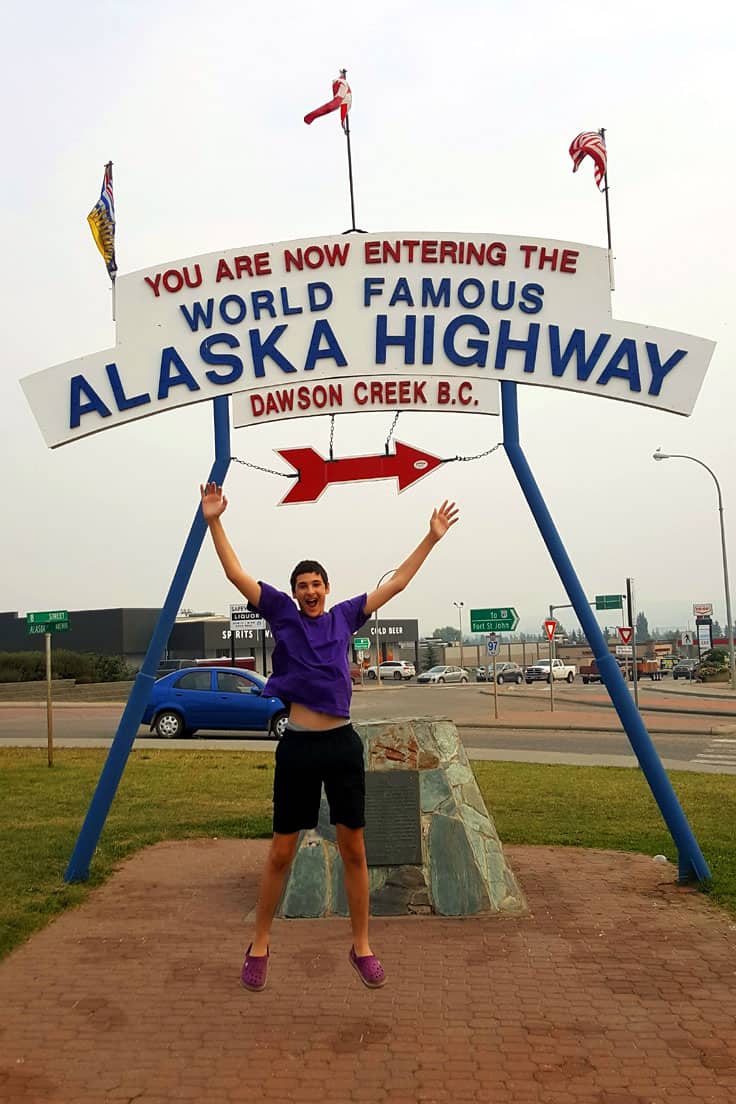
Among Dawson Creek's historical attractions, the Kiskatinaw Bridge stands out. Once part of the original Alaska Highway, it now serves as a testament to the engineering feats of the past.
Another notable site is the Walter Wright Pioneer Village, offering insights into the early days of Dawson Creek through a collection of historic buildings and artifacts.

Reflecting on Our Time in Dawson Creek
Our route to Alaska took us via the Cassiar Highway on the way up and back via the Alcan, positioning Dawson Creek as the final waypoint on our Alaska Highway adventure.
Standing next to the Alaska Highway sign, we felt a mix of accomplishment and nostalgia, marking the end of our journey along this historic route, rather than its beginning.

Our time in Dawson Creek was brief, yet meaningful. We seized the opportunity to drive through the historic Kiskatinaw Bridge, taking a short detour that connected us more deeply with the highway's storied past.
This moment was especially poignant, given our accumulated knowledge and experiences of traveling the Alaska Highway.

Seeing one of the original bridges up close was more than just a side trip; it was a major highlight that captured the essence of adventure and the deep history of the Alaska Highway.
2. Fort Nelson, British Columbia
Fort Nelson, between Dawson Creek and Watson Lake, is a small town with around 4,000 inhabitants. It serves as a strategic pause for travelers on the Alaska Highway, offering more than just essential amenities like stores and motels.
The Fort Nelson Heritage Museum, with its focus on the Alaska Highway's history, is a highlight, providing visitors with a deeper understanding of the road's significance and the region's past.
Reflecting on Our Time in Fort Nelson
Our journey through Fort Nelson became unexpectedly memorable when we decided to chase the Northern Lights.
The local visitor center, spacious and well-equipped, provided us with a wealth of information and welcomed us with the warmth of hospitality through its free WiFi and friendly staff.
Motivated by the night's promising aurora forecast, we settled in Fort Nelson for the evening, hopeful for a celestial show. Unfortunately, the lights remained shy that night.
But nature had a surprise for us later on our journey. In Beaver Creek, a small town on the Alaska Highway, we unexpectedly saw the Northern Lights.
We spotted the green lights shining in the sky from our room. Quickly, we drove a short distance from the town to get a clear view and saw an amazing display of the Aurora borealis.

The spectacle lasted for about fifteen minutes, a brief but unforgettable performance that became one of the most cherished memories of our trip.
The photograph here, captured with nothing more than my phone, barely does justice to the experience. One of the most memorable experiences of our entire trip.
3. Muncho Lake, British Columbia
Muncho Lake, set in the Canadian Rockies along the Alaska Highway, is known for its jade-colored waters. It gives visitors a peaceful experience in the national park around it.
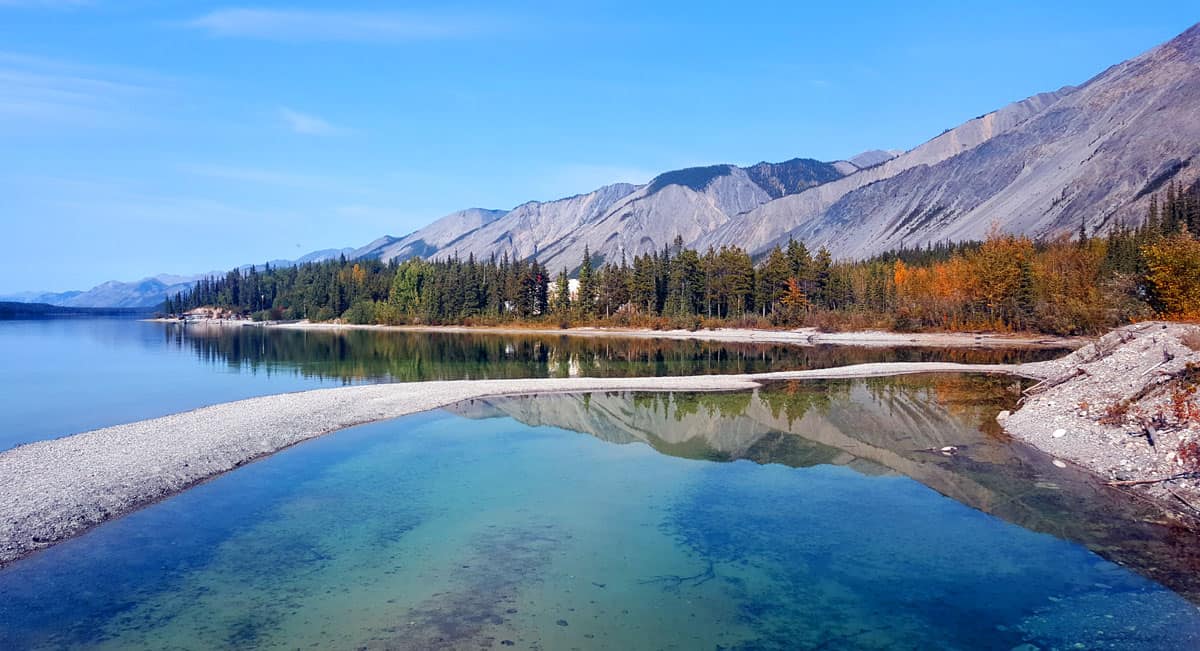
For those looking to extend their stay, local campgrounds provide a serene base for exploring the area's hiking trails, though it's worth noting that these facilities close seasonally in September.

Reflections on Our Time at Muncho Lake
Muncho Lake impressed us deeply. Located within a National Park, it marked our journey from the Yukon wilderness into the stunning Canadian Rockies.
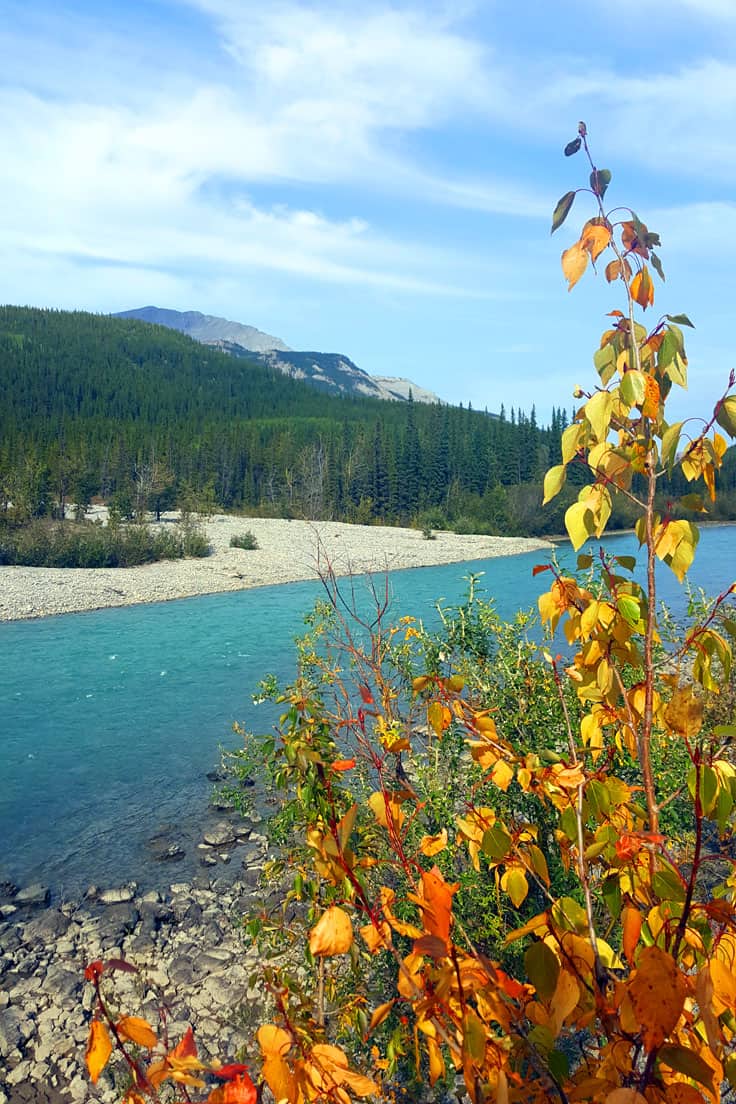
The stunning scenery demanded several pauses along our route, each time to capture its splendor through our camera lens.
4. Liard Hot Springs, British Columbia
Liard Hot Springs is an oasis in the midst of the rugged Alaska Highway landscape. Located within the Canadian Liard River Hot Springs Provincial Park, these thermal pools offer a unique respite for travelers journeying along this remote path.
Recognized for its natural beauty and warmth, it is a compelling destination for those traversing the highway.
Here's a brief video highlighting recent upgrades at Liard Hot Springs, showcasing the improvements made for visitors.
Reflections on Our Time at Liard Hot Springs
Regrettably, our visit to Liard Hot Springs did not include the immersive experience of soaking in its famed thermal waters. On that particular day, the prospect of changing attire and entering the springs didn't align with our travel mood.
5. Watson Lake, Yukon
This small community is strategically placed near Mile 635 on the Alaska Highway. This means everyone stops here.
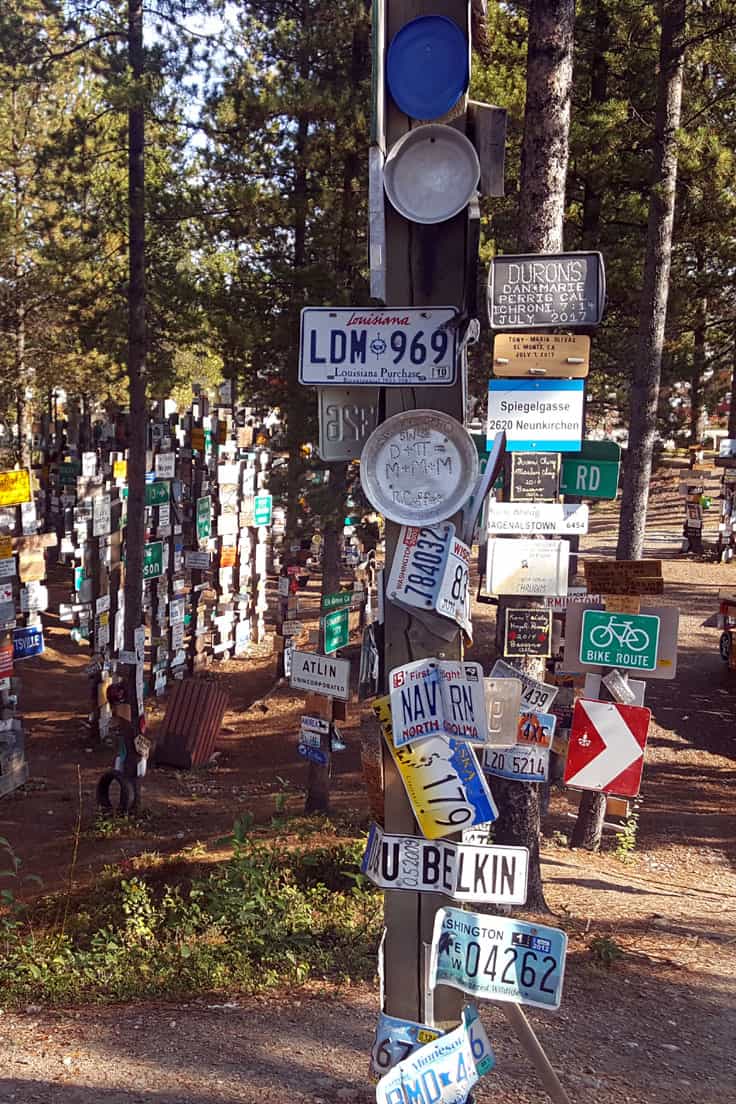
In fact, travelers from all over the world are the ones who created the town's most famous attraction: The Sign Post Forest. Just what it sounds like, it's a small forest made of signposts from all over the world.
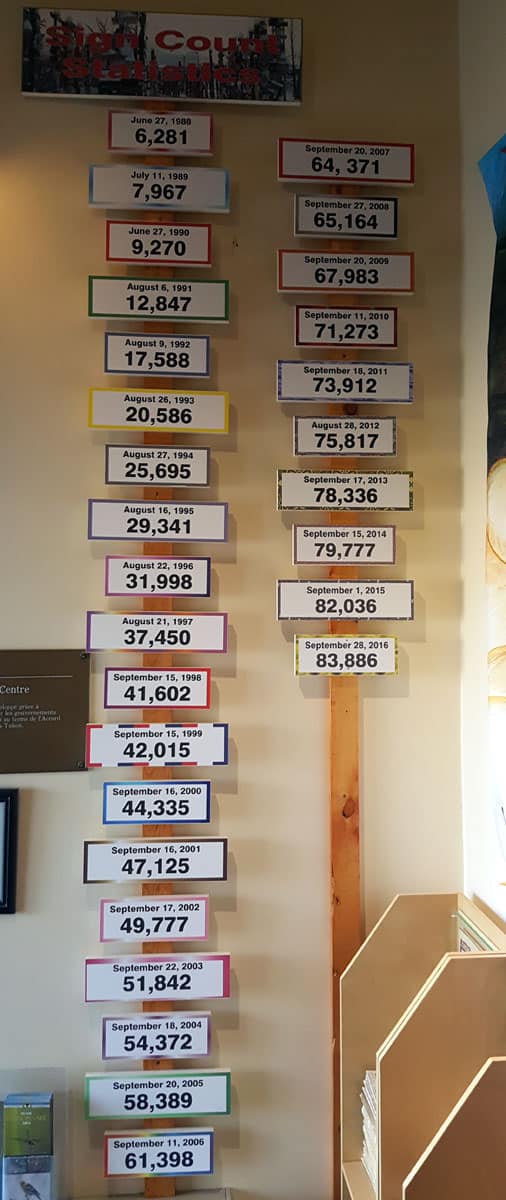
Reflecting on Our Time in Watson Lake
Our stopover in Watson Lake transformed an ordinary night into an exploration of the world-famous Sign Post Forest the following morning.
This attraction, far more expansive than anticipated, captivated us with its vast collection of signposts from across the globe.

If you visited Watson Lake in the 1980's you probably only saw 30-40 thousand signs. Today it's more than double that.
6. Rancheria Falls
Rancheria Falls, situated off the Alaska Highway 1, offers travelers a delightful opportunity to stretch their legs and immerse themselves in nature's tranquility.
This easily accessible spot is perfect for most visitors, featuring a well-maintained trail and walkway that leads to a scenic viewpoint within just a 500m walk.

Reflections on our time in Rancheria Falls
Rancheria Falls provided a charming interlude in our journey. This spot introduced us to a brief but delightful hike, perfect for families, with stunning views of the Rancheria River and the cascading falls.
Conveniently available restrooms were a much-appreciated comfort during the long stretches of road. We recommend future travelers mark Rancheria Falls on Google Maps before setting out, as the area's lack of cell and data service emphasizes the need for pre-trip planning.
7. Teslin, Yukon
Teslin, a modest village within the Yukon, honors the rich heritage of the Tlingit nation. Despite its small population of fewer than 150 residents, Teslin is notable for being one of the largest First Nation settlements in the region.
The village is home to three museums that come highly recommended by travelers: The Teslin Tlingit Heritage Centre, the Northern Wildlife Museum, and the George Johnston Museum, each offering unique insights into the local culture and history.

Reflections on Our Time in Teslin
Our exploration led us to the George Johnston Museum, an enriching experience that was both educational and enjoyable.
The museum showcases the remarkable story of George Johnston, a Tlingit native who, in 1913, brought a car to Teslin, a time when the Yukon was devoid of roads.
Johnston's ingenuity led him to operate as a taxi driver across the frozen lake surfaces, demonstrating a fascinating blend of innovation and tradition.
Inside the museum, Johnston's car remains as a tangible link to the past, while the exhibits around it delve into the Tlingit heritage, providing a comprehensive understanding of the community's enduring spirit and resilience.
8. Whitehorse, Yukon
With a population of more than 23,000, Whitehorse is the largest town in the entire territory. It's a great place for a longish stopover. It has everything you need in a town, plus several sightseeing attractions. These include:
- Miles Canyon - Trails that take you through a beautiful canyon and some historic sites. Read more.

- The SS Klondike - A former gold rush ship turned into a national historic park and museum. Read more.
- The Yukon Beringia Interpretive Center - A small museum that explores the ice age land bridge between North America and Asia. Read more.
- The MacBride Museum of Yukon History - Another small museum covering local history, including natural history. Read more.
- Kwanlin Dun Cultural Centre - A cultural center for the Kwanlin Dün First Nation people. Read more.
- Yukon Wildlife Preserve - A conservation and research center where you can see many types of local wildlife. Read more.
Reflections on Our Time in Whitehorse
Our four-day stay in Whitehorse was a highlight, deserving of a dedicated blog post.
We explored several key attractions, including the SS Klondike, The Beringia Interpretive Center, the Yukon Wildlife Preserve, and Miles Canyon, each offering unique insights into the area's history and natural beauty.
Whitehorse also provided a much-needed pause in our journey, allowing us to recharge before continuing our adventure. This town, with its blend of cultural and natural attractions, proved to be an indispensable part of our exploration of the Yukon.
9. Haines Junction & Kluane Lake
Haines Junction, a quaint town with just over 500 residents, is the gateway to the breathtaking Kluane Lake and the vast expanse of Kluane National Park and Reserve.
This area in southwest Yukon is about 160 kilometres west of Whitehorse, is a treasure trove of natural beauty and outdoor adventures.
The town's strategic location at the crossroads of Haines Highway and the Alaska Highway provides easy access to the park’s eastern trails, offering opportunities for hiking and camping amidst stunning landscapes.
While much of Kluane National Park's rugged interior remains a wild frontier accessible primarily through flightseeing tours or ambitious mountaineering expeditions, the areas accessible by road promise equally compelling experiences.

Reflecting on Haines Junction & Kluane National Park
Our journey brought us to Haines Junction and the vast expanse of Kluane National Park, a truly grand spectacle. Traversing the Alaska Highway, we encountered the park from both directions, discovering that Kluane Lake was merely the beginning of its wonders.

The visitor center in Kluane stood out, not just for its impressive architecture but also as a modern oasis in the wilderness, complete with WiFi.
This small luxury became a surprising highlight, especially for our kids, who reveled in the brief return to connectivity amidst our remote travels.
Spanning the Canadian side of the Wrangell St. Elias mountain range, Kluane is a testament to the untamed beauty of the Yukon.

Its vast wilderness mirrors the remote reaches of Wrangell-St. Elias National Park across the border, with much of its majesty hidden away from easy access.

While a comprehensive exploration would require either a flight or a challenging hike, the views from the Alaska Highway provided us with a generous glimpse into its pristine landscapes.

These moments of natural beauty and serenity, captured in snapshots of our adventure, were among the highlights of our trip. A particular favorite was our rental SUV set against the picturesque backdrop of Kluane Lake.

10. The Alcan–Beaver Creek Border Crossing
The Alcan–Beaver Creek Border Crossing shows the historical and strategic importance of the Alaska Highway. Located at a pivotal junction, this crossing links the United States with Canada, specifically between Alaska, USA, and Yukon, Canada.
It is situated on the Alaska Highway, a crucial route established during World War II to connect the contiguous United States with Alaska through Canadian territory.
Beaver Creek, the westernmost community in Canada, sits on the Yukon side of the border, offering travelers their first or last glimpse of the country depending on their direction of travel.
The crossing itself has evolved over the years, from a simple log cabin to the modern steel structure completed in 1983, located 28.6 kilometers (17.8 miles) from the actual border—making it the Canadian border station furthest from the border.
Reflecting on Our Time at the Border Crossing
Stopping at the border between Canada and Alaska offered an experience in its own right. The vastness of the region is highlighted by the surprising fact that a full 15 miles separate the Canadian border station from its American counterpart.
As we journeyed into Alaska, passing through the Canadian checkpoint led us into a 20-minute drive before officially crossing into Alaska, marked by a distinct sign and a sturdy border post.

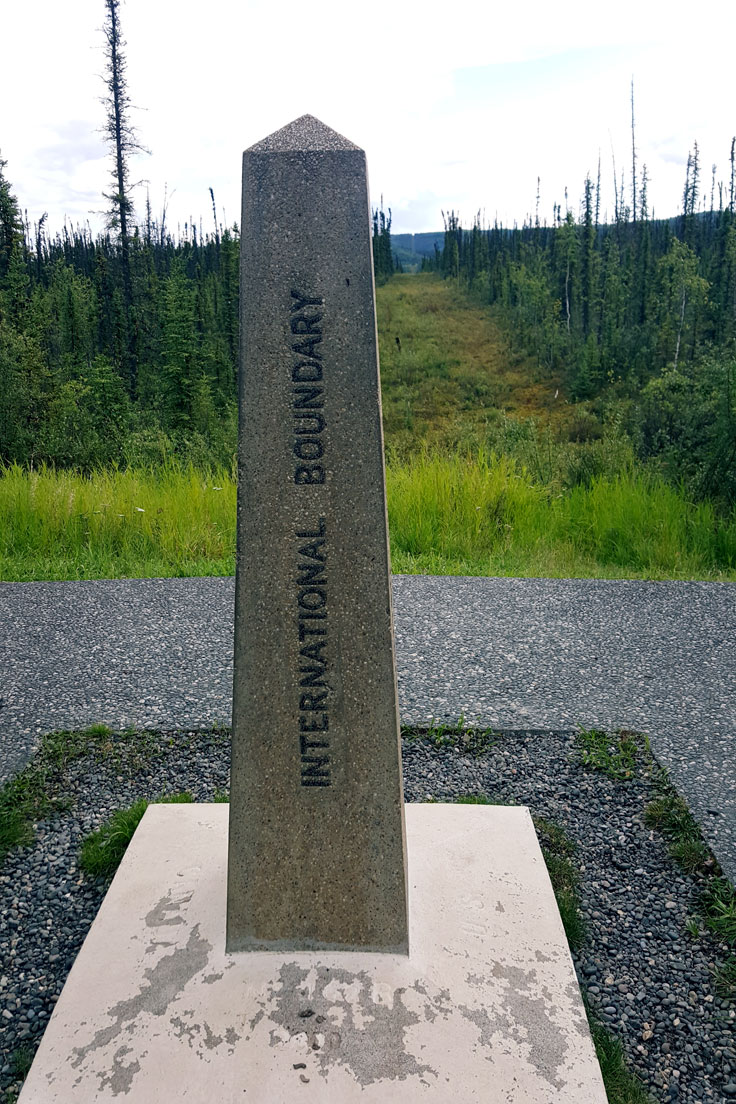
The absence of border control personnel across this stretch allowed for an unusual freedom—to casually step from one country to another as if merely crossing a street.
The border post itself, a significant and immovable marker, became a playful symbol of our adventure. We humorously attempted to shift it, half wondering if our actions could somehow redraw national lines.
Fortunately, the border stood firm, sparing us from inadvertently sparking an international incident. This moment, whimsical yet profound, underscored the vast and open nature of our journey along the Alaska Highway.

11. Tok
Tok, Alaska, is a pivotal junction for travelers navigating the Alaska Highway.
While the town itself may not boast a plethora of attractions, its strategic location offers a moment of contemplation for those at a crossroads: continue northward to Fairbanks or veer west towards Anchorage and the Kenai Peninsula.
For those considering their next move, Tok provides essential amenities, including several motels and a well-equipped visitor's center, making it a convenient pit stop.
Reflections on Our Time in Tok
Our experiences in Tok were in line with the town's reputation as a practical waypoint rather than a destination rich in activities.
On both our journey to Fairbanks and our return trip, Tok presented itself as a quiet place to refuel, both literally and figuratively, with its selection of gas stations, modest dining options, and lodging.
The town's simplicity underscored its role as a functional pause in our travels, offering a brief respite before continuing on the grander Alaska Highway adventure.
12. Delta Junction
Delta Junction proudly marks the end of the Alaska Highway journey. Home to about 1,000 residents, this community not only signifies a traveler's successful completion of the Alcan but also invites a deeper exploration into Alaska's pioneering history.
Attractions like the Big Delta State Historical Park and the Sullivan Roadhouse Historical Museum, the oldest roadhouse in the state, offer a window into the rugged early days of Alaskan settlement and development.
Reflections on Our Time in Delta Junction
As we got to Delta Junction, it started to rain, creating a peaceful scene at the end of the Alaska Highway. Our next stop was Fairbanks, so we chose not to explore Delta Junction's history this time.
This quick visit to Delta Junction reminded us there's so much more to see and learn along the Alaska Highway for next time.
Reflecting on Our Alaska Highway Journey
Driving the Alaska Highway was an incredible experience. The quality of the roads surprised us positively. We traveled to Alaska in August and returned in September.
Along the way, we encountered a stretch with rough pavement and significant frost heaves and potholes, especially as we neared Alaska. It seemed like the road maintenance was less prioritized near the US border.
Here's how our vehicle looked by the time we reached the border:

Our SUV by the border. Despite the rough patches, there was no significant damage, just a testament to the adventure.
Apart from that challenging section, navigating the rest of the Alaska Highway was straightforward, with well-maintained roads facilitating a smooth drive. As we ventured further north, the landscape became more secluded, easing our travel with minimal traffic.
Beyond Fort Nelson, cell service was nonexistent, even within towns, a reminder of the remoteness of the region. Relying on WiFi at roadside motels was not an option, with limited to no internet access, except in Whitehorse and Watson Lake, where we found somewhat reliable connections.
Our journey along the Alaska Highway was memorable, filled with the raw beauty of the landscapes and the charm of the northern communities. It's an adventure we highly recommend to anyone with a love for the open road.
Have you traveled on the Alaska Highway, or is it on your list of future travels? I'd love to hear your thoughts and experiences in the comments.


Thank you for sharing your trip highlights! I live in British Columbia and used to lived near the Yukon Border. We traveled the Alaska highway for many years and I’ve never heard it referred to as the “Alcan” Highway. Alcan destroyed much of my ancestral lands when it flooded the Ootsa Lake country in the 50s, how is their name attached to the Alaska Highway?
Hi Valerie,
Interesting question. I basically saw others use it. Here’s how Wikipedia opens their description of the road –
I sort of assumed Alcan simply stood for Alaska-Canada highway. I wasn’t even aware of the Alcan company (I had to Google it just now). Seems like the company is named after Aluminum mining in Canada. It’s an interesting question as to who started calling the highway Alcan too and why.
We are planning to take the trip in August and September. We are torn between taking our Jeep with a roof top tent or our motor home towing the Jeep. Any advice, suggestions will be appreciated.
Hi Barabra,
I think you could go either way in August and early September. Mid-September, I would prefer to stay in a motorhome for better insulation. I guess you could always stay at a motel on cold nights though.
Came across your posting and it sure stirs up the memories. Our last trip over the Alaska Highway was in 2016 which made for the 6th time we have travelled that way from Wisconsin. (Our son and daughter-in-law lived in Wasilla until moving back home in 2016) Oh the adventures we have had as each trip was made starting in 2005 pulling an RV – the last 3 trips were with our larger 5th wheel. We found that over the years, there was notable improvements to the roads throughout Canada. We think the section between Destruction Bay and the border will always be an issue – constant frost heaves and tundra that is becoming more and more unsettled but if you slow down and drive accordingly, you will be fine. Kluane Lake has to be one of the most spectacular landscapes (recommend Cottonwood for a camping experience – right on the shore and grizzly bear signs posted everywhere – limited power running off generator/very spotty wifi) Once you cross the border into Alaska and choose the Glenn Highway into the Anchorage area, take your time there too – the Glenn becomes very narrow and winding with minimal safety features in many areas particularly if you are pulling RV’s, etc. The other direction up to Fairbanks is probably less fraught with hazards. Take your time whatever route you choose…Valdez for salmon, Homer for halibut, Denali for jaw dropping scenery…you could live 6 lifetimes and never see it all…
Thank you for sharing your experiences with us, Pat! This all sounds fantastic. I can’t wait till we repeat the trip in our own RV someday!
Would love to drive from Calgary to Fairbanks and then switch to the train, followed by the ferry. (Our plans are a moveable feast at the moment!) We’d love to go in June, as we’ve been to Alaska before and this suits us best. Can’t find a rental company willing to pick up near the border and drop at Fairbanks/Anchorage – any ideas???
Hi Rosemarie,
In my experience, renting in Canada and returning in the US – or the other way around – is very complicated. If you could find a rental company that would agree to do that it would probably cost you a lot in drop-off fees too. I can totally see how you simply can’t find a rental company for that route. My only advice would be to change your plans so that you rent and return the vehicle within Canada. Maybe return drive back to Whitehorse, return the vehicle there and get someone to take you to Haines or Skagway? That way you can catch the ferry from there. https://tripmemos.com/wp-admin/edit-comments.php#comments-form
Read all of your article and found it very useful. My wife and I along with 9 other couples are planning on travelling this route all the way to Denali and Anchorage and anything in between in June of 2019. We each have our own trailers or campers and are in the process of planning out our journey so we are reading up on what ever publications we can get to. We have 2 wagon masters who are working on the route and we are calling this our trip of a lifetime. We are not rushing and hope to make the most of our journey along the way. Thanks Again.
Hi Ken,
This sounds absolutely fantastic! Our plan/fantasy is to buy an RV and keep it in the US for several years, coming to travel for half a year out of every year (we live in Israel). This will have to wait until we’re at least semi-retired, so probably 5-6 years from now. I can totally relate to learning a lot in advance. I had been planning our Alaska road trip for years before we actually did it. Now I’m researching RV’s, trucks etc. to be prepared when the time comes. I actually started a small blog about that, just keeping track of what I’m learning. If anyone’s interested it’s at http://www.VEHQ.com. Very early days though – just a few posts at this point – but I’d love to get comments from like-minded future RV travelers!
how is the motel availabilty injuly and august?
Great question, hunter! It bothered me before we went there. What I found was that it’s easier to find a reasonably-priced motel in August and September along the Alaska Highway than it is in Alaska itself. Alaska is super expensive so I would highly advise anyone going there to make reservations even 10-12 months ahead of time.
The Alaska Highway doesn’t work like that, apparently. Because it’s difficult to know how much driving you’ll end up doing, people book accommodation that far in advance. Many motels along the road don’t have internet so they don’t get online reservations. We stayed in Fort Nelson, Watson Lake, Whitehorse and a couple of places that were literally “along the road”. The only place we made reservations in advance was Whitehorse. Had no problem finding available motels in the other locations and prices were very reasonable (around $100-120CAD for a family of four).
Hello all that may read this,
Myu name is John and I travel the AK Highway many times each year. 67 times so far! I just wanted to mention to any new travelers on the Alcan, it isn’t all about attractions or towns and museums. To those that rise early, it seems to be the best time to view wildlife. Although I have seen wildlife at all time of the day and night. I personally believe Apr. 15 – June 15 is the best travel time to see wildlife. Newborns of all species are out and about with mom and are a joy to see. The weather may be cooler in April, but I have had great driving in most late Apr. trips… snow can come at any time in the mountains, so stay informed of the weather. My best suggestion to anyone traveling the Alcan, is keep your eyes open, look back into the brush, behind trees and along rivers, and take time to view at the pulloffs and rest areas. Happy travels and be careful!
ps: take time to talk to the locals, some have some great stories and many can point out places to see and visit.
Thanks for stopping by and leaving a comment, John! I totally agree with your recommendation! We returned from summer our road trip, traveling the Alcan (and the Cassiar too!) in August and September. We loved the wildlife and the sense of wilderness. We saw bears, moose and wood bison along the way and had a great time just being out there and absorbing. Will definitely be back for a spring drive someday!
We are currently in Dawson Creek. The your post is very helpful and we plan to stop at each of them either on the way up to Fairbanks on the way back. We also have The Milepost.
Thank you for taking your time to post this.
That’s awesome, Tina! We’ll be starting our own LA to Alaska and back road trip in less than two weeks!